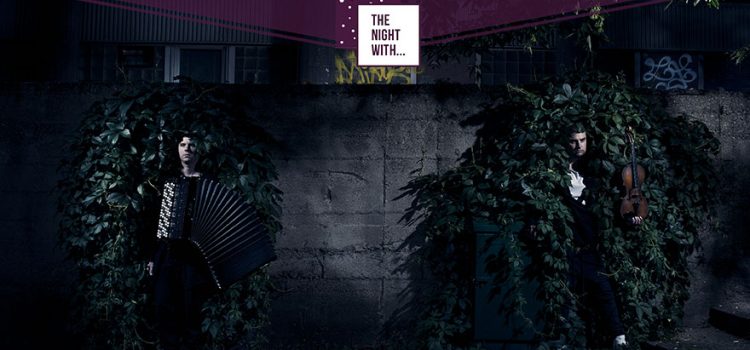New Polish Music for accordion viola dedicated to Duo van Vliet
Rafał Łuc writers about music for viola and accordion written for Duo van Vliet. Originally published Modern Accordion Perspectives #4 www.modernaccordionperspectives.com
Duo van Vliet will be performing at The Night With… on the 20th, 21st and 22nd August in Edinburgh, Glasgow and Aberdeen. www.duovanvliet.com
Duo van Vliet is an accordion and viola ensemble founded by myself and Scottish musician, Ian Anderson. We met at the Royal Academy of Music in London where we both studied. We have been playing together for seven years, since 2011, and have given recitals in venues such as Bridgewater Hall (Manchester), St. Catherine Church (Vilnius), National Portrait Gallery (London), Glasgow University, National Forum of Music (Wrocław), Grażyna and Kiejstut Bacewicz Academy of Music in Łódź, National Symphony Orchestra of Polish Radio (Katowice); and at festivals such as Podium Festival in Esslingen (Germany), St Magnus Festival (Scotland), International Contemporary Festival Poznań’s Musical Spring, International Contemporary Music Festival Warsaw Autumn.
Duo van Vliet emerged by a little accident: the viola player with whom I was supposed to play in a competition at college needed to go abroad at short notice and recommended Ian Anderson as a replacement. We worked together so well that we decided to keep playing together, and we are still going.
Initially we had very little knowledge about the original repertoire for accordion and viola so we were performing works by John Sebastian Bach and Astor Piazzolla. We also made arrangements of violin and piano or accordion and cello repertoire. But it around our interest in two British composers – John Dowland and Benjamin Britten – that we really began to find our voice. Therefore we decided to use them as the focus around which we would build our first album.
Our debut CD, Lachrymae ReVisited, was released in June 2017; it contains five chamber pieces and two solo works. Two of the compositions were originally written for our set-up of accordion and viola. One of them is ReVerse 2 by Adam Porębski, a young Polish composer from Wrocław, who is also an academic lecturer at Karol Lipiński Music Academy in Wrocław. The piece was awarded the First Prize ex aequo of the National Composer’s Competition in Poznań in 2013, the world premiere taking place during the International Contemporary Festival Poznań’s Musical Spring 2014. The score is published by Ignacy Jan Paderewski Academy of Music in Poznań.
The composer wrote the following programme note:
“So what is the meaning behind the ‘reverse’ of the title? Does it refer to the reversing of the traditional hierarchy of music, in which melody and rhythm persist, but only in articulation, density and harmonics of sound? Or maybe it is about the reversing and reflecting of instrumental sounds, like in a mirror — either combining to form one homogenous tissue, or refracting and dispersing? Possibly ReVerse 2 should be interpreted less literally, as compositional aesthetic metamorphosis? Or maybe ReVerse is a violent change of the composer’s outlook?” ( Adam Porębski, ReVerse 2, programme note in: Lachrymae ReVisited, Orchid Classics ORC100069).
ReVerse 2 is a single-movement composition constructed of five phases. The piece begins in the highest register of accordion and viola, the musical material based around the idea of sound penetration between instruments.
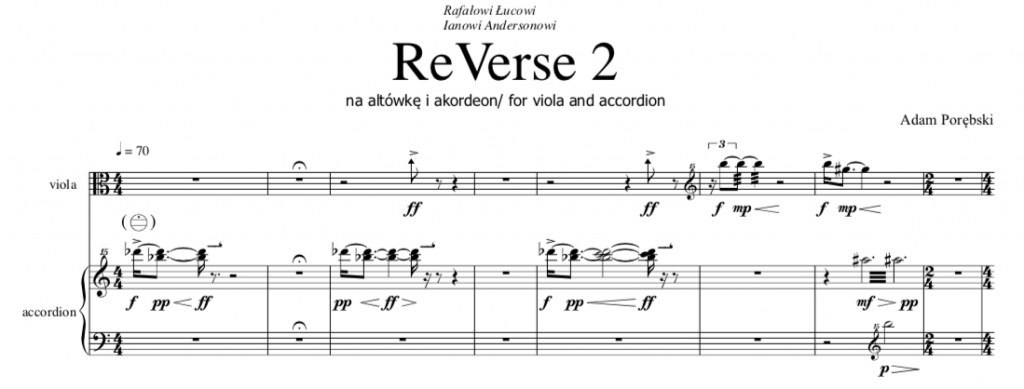
After a short transition of cadence character, phase two is situated in the lowest register. There are many glissandi (tone glissandi in the accordion part) throughout that section. The next section’s material brings further sound deformation. In the accordion part this is achieved with the help of the mixing of registrations, and also by adding the air valve sound.

In the viola part, this destruction of tone is achieved through scratching in the beginning (the use of too much bow pressure on strings) and later by sul ponticello technique.
”Percussive” material dominates in both parts in phase four, with only occasional pitches occurring. The playing techniques are familiar to contemporary music. In the accordion part the following techniques are used: air valve, register clicks in the right and left hands, quiet glissandi played on the keyboard, and a ”guiro” effect performed on the grill of the instrument. These elements are all mixed up with each other.

The end of the piece is based on long notes in the accordion part, beginning in the lowest register and moving gradually towards the highest register. In the foreground, the viola plays short ”fragmented” melodic contours in contrast to the accordion, as the accordion transitions from the lowest register to the highest, harmonic register. The drama gradually subsides in both dynamics and normalising of register.
The above techniques and processes, at work throughout ReVerse 2, show how brilliantly Adam Porębski – at twenty three years old – came to know the abilities of the viola and accordion, both separately and together. Adam consciously pushed both instruments to their extremes: their full ranges, extreme dynamics, and also extended techniques. The piece is a real ”journey” through the technical abilities of the instruments, and I hope that because if its undeniable quality, it will become standard repertoire for other performers.
ReVerse 2 was written for us in 2013 as we wanted to add a contemporary piece to our concert programmes and album. I think that it was also at that time when we realized how much we enjoyed working on contemporary music, putting it together in rehearsals, and – most importantly – that in order to build an identity for our duo, we should focus our attention on contemporary music and on commissioning composers to write specifically for our duo.
Another piece composed for us which I would like to mention is <<<st)i(ll<<< for amplified viola and accordion (2016/2017) by Marta Śniady. She is a composer from Łódź and lately she has been studying on a soloist programme at The Royal Academy of Music in Aarhus, Denmark with Simon Steen-Andersen and Niels Rønsholdt.
She writes in the programme note: ”<<<st)i(ll<<< is rough, brutal, primitive, dirty. The key aspect to understand the piece is the way the title is written. <<<st)i(ll<<< starts where most stories end, in the climax. Strong feelings in the beginning decrease with time. The viola and accordion aim to a common point, in which it seems the emotional quivering finally subsides but for one sound, a familiar smell, taste, a touch which awakes repressed and muted emotions. <<<st)i(ll<<< is also a technical study, an attempt to achieve maximum possibilities from a single decreasing motive, which is determined by different aspects: tempi, accents, colour, articulation, volume, and rhythm intensity. I am interested in overlapping contradictory processes, i.e. rhythm density with height and volume descent; processes which co-operate against their natural instincts, against each other”.
According to the programme note, Marta Śniady’s piece is a study of many extended techniques, both for viola and accordion. In contrast to – but also mirroring – Adam Porębski’s ReVerse 2, she begins her work in opposite extreme registers (lowest in the accordion and highest in viola); the climax (of anti-climax character) is set in the middle range of instruments and the piece finishes in the highest register for both instruments.
The main feature of an accordion part is the use of different register setups, which change fluently. Apart from detuning and distorting the sound, it also gives the rough and dirty character mentioned above. The composer often strengthens the process with a use of tone-glissandi or air valve sound on top of it.
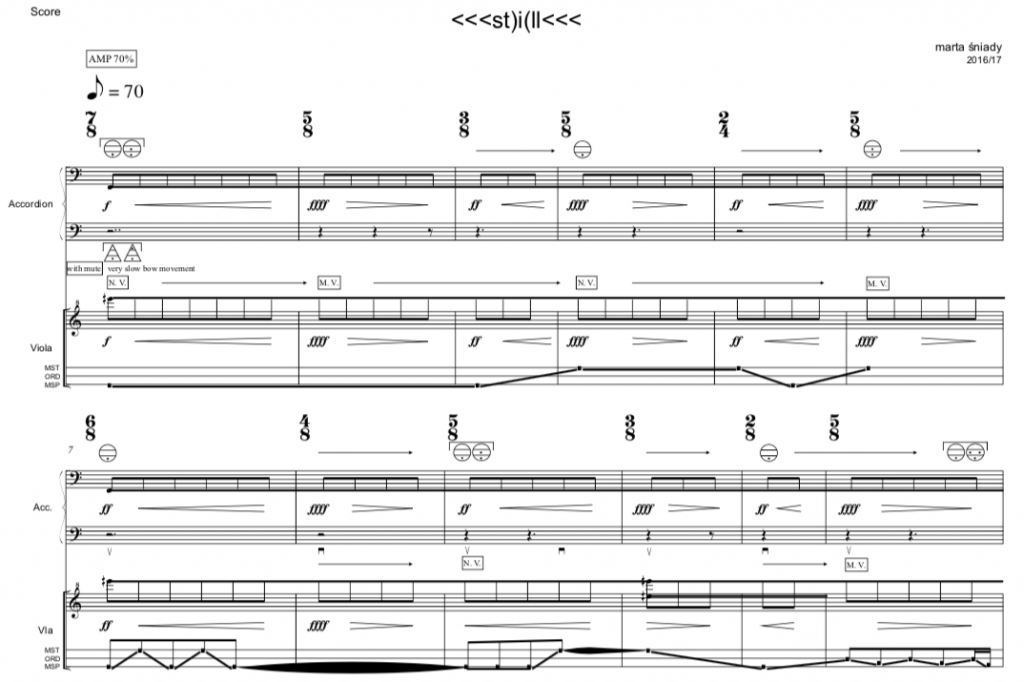
Aside for the extended techniques used throughout the whole piece like key clicks, ”guiro” effect, air valve there are also standard elements being used like clusters, bellow shake, ricochets , vibrato, repetitions.
The viola part is extremely demanding and a performer can find all the spectrum of different techniques like harmonics, bow-scratch effect on strings, use of bow in lateral directions and its different parts. Moreover, part of the bow is prepared by sticking some tape on the wooden part.

These performance techniques are played mostly in the highest range of viola which is not particularly common for the instrument and demands practise time. From our experience we can admit they are worth challenge because with the enough spent time there are totally possible to achieve and the final effect is very astonishing. The score delivered by the composer was precisely annotated and did not lot leave much freedom to the performers. However, in the end there is an improvised section which accumulates bits from previous parts of the piece. Each performer can choose the order they appear and the density of that section.
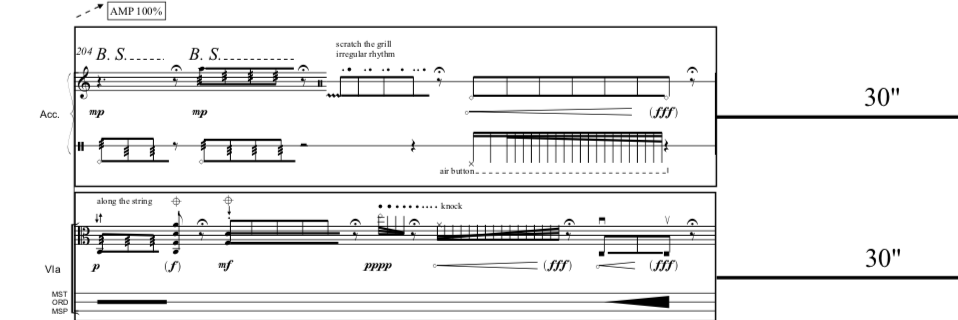
This is also the moment where amplification plays an important role and starts to be more noticeable. Within the whole duration the piece is meant to be slightly amplified (around 70%) in order to bring up some details which could be inaudible if the piece was played acoustically. Of course, the amplification level depends on many factors, especially venue acoustics. In the improvised section from Example 6, the amplification increases to 100% in order to let those details fulfil an independent role and come to the fore.
Healing Nature & Joy of Music is a piece written (2016) by Jacek Sotomski for accordion, viola and video. He is a graduate of Agata Zubel’s class in the Karol Lipiński Academy of Music in Wrocław. In order to understand the essence of the composition I need to quote Jacek Sotomski on meeting Jennifer Walshe and his subsequent change of style:
”After [the composition course in] Ostrava I stopped being interested in autonomous pieces to be lived hedonistically. I started to be interested in more critical things, directed towards social or cultural aspects. Maintained in a trend of relational aesthetics and new conceptualism, which deals more with mixed artforms, such as music combined with video or theatre… I became uninterested in writing for clarinet, piano, violin and cello. There are hundreds of pieces like that (…) and in some of them someone may come up with new clarinet multiphonics or other extended performance techniques. I am more interested in meta-narration.”
Post-Internet is an aesthetic in which I can realise myself after I decided, camp (kitsch) is dead. Post-Internet draws from the things which are around us, Internet, but in a very meta and contextual way. The term post-Internet was created 10 years ago in visual art and funnily enough, straight away it stopped making sense. (…) Post-Internet was meant to deal with things we do in real life after we have spent some time on the Internet, but nowadays we are always connected to the Internet. There is no such thing as life after Internet and this is very interesting… (…)”.
As the composer explains Healing Nature & Joy of Music is his first post-Internet piece. For the first time he uses the video in his art presenting non-conventional medicine treatments.
Musicians’ role is to perform mainly extended techniques which are in some sense the soundtrack to the video layer. The accordion part is a mix and accumulation of sounds like air valve, ”percussive” effects played on bellow, keyboard, grill, converter, registers (some of the are performed with a bank card), ricochets, and clusters. The viola part is based on extended string techniques; for a large part of the piece the instrument is also prepared by putting a rubber band on a tailpiece. In the whole piece there are only 13 bars with determined sound heights.

The composition is a comparison of the extended performance techniques (as a symbol of the contemporary music language) with the video presenting non-conventional medicine, which according to the composer neither work in music nor in a real life.
The last piece I would like to mention which has been written for our duo is Mikołaj Laskowski’s Deep Relaxation Vol. 1: Viola & Accordion DNA Delete Mode (2016) for accordion, viola and electronics. The world premiere took place in Podium Festival in Esslingen in May 2017. Mikołaj Laskowski studied in Wrocław with Grażyna Pstrokońska-Nawratil, later he continued his education in The Royal Conservatoire in The Hague with Yannis Kyriakides.
The programme note introduces the idea for the piece: ”Deep Relaxation is a series of products from Musax corporation whose primary goal is to enable consumers to make conscious and artistically refined musical choices, answering their evolving needs and supporting the well-being of families throughout the world. We consistently invest our resources in the process of perfecting existing products and developing new ones. The Deep Relaxation series combines the latest technology with ancient (or at least as old as the internet itself) knowledge about so-called solfeggio frequencies. Each part of the cycle is based on carefully selected frequencies, aimed at improving various life parameters, enhancing well-being, and unlocking energetic centres responsible for various ailments on the physical, psychological, and purely existential level. However, deep transformation is impossible without destruction, thus exposure to solfeggio frequencies must begin with DNA Delete Mode.”
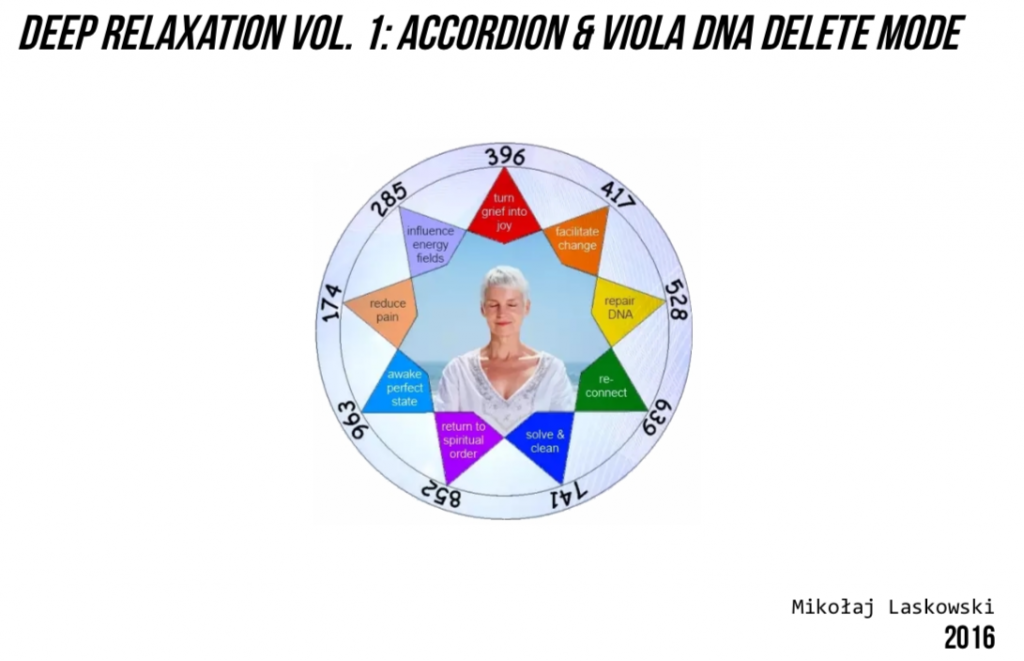
As the composer explains, the piece is a part of a series ironically connecting to the relaxation music. The composer created a fictional company (not for the first time) which produces music on demand and treats it as a merchandise. The genre of relaxation music, which mostly has a functional character is transferred to concert venues.
Polish music critic, Monika Pasiecznik, wrote about the composition: ”Title Deep Relaxation sounds quite provocative in the musical avant-garde context, which aimed to shock the listener instead of make him relax. In Mikołaj Laskowski’s music, which we try to input in that context, irony and nostalgia, electronical daub and refined instrumental sounds, omnipresent sampling and Internet plunderphonics are combined with satirical connection to New Age aesthetics. As we remember, this culture grow out of belief that humanity crushed in a deep crisis is at the turning point between two eras. Isn’t it a contemporary music situation, suspended between still alive post-Lachenmann avant-garde and new generation experience which is digital revolution and Internet? Mikołaj Laskowski’s music is a reflection of schizophrenic consciousness of his generation”.
In this composition, both instruments are prepared. The viola is lain flat on a table in front of the performer. There are long magnetic VHS tapes are attached to strings symbolizing DNA. The violist performs gestures, rubbing the tape with their fingers and scraping a piece of paper down the strings; it is obviously not a part to be performed in a traditional way. The accordion is prepared with thin pieces of paper placed under the set of right hand reeds, with the aim of blocking the movement of air within the instrument. These preparations distort the sound and do not allow the performers to play smoothly on the instruments.
The piece does not present any traditional sounds of instruments. The whole material is manipulated with electronics. In addition, the composer uses effects such as tone glissandi, key-clicks and extreme registers of both instruments. One of the highlights of the composition are reed harmonics which are achieved by preparation of the accordion.
Of course, in our repertoire there are more pieces written for our duo, also by composers from older generation like Rafał Augustyn or Cezary Duchnowski. But in this article I wanted to present the youngest generation of composers. Adam Porębski, Marty Śniady, Jacek Sotomski and Mikołaj Laskowski are artists around the age of 30, who already have a big concert experience, many performances in the most important festivals of Polish contemporary music (Warsaw Autumn, Musica Polonica Nova, Poznań’s Musica Spring), awards, commissions and co-operation with fantastic ensembles, conductors and performers specializing in contemporary music. They belong to the millennial generation, speak fluent English, travel abroad for concerts and festivals as active members (Darmstadt, Ostrava, Radziejowice), and study composition in prestigious schools with most important composers or during summer courses. Because of that they realise what is currently happening in the contemporary music world.
In the past, when there was no Internet and when real borders (especially in Europe) existed, in order to find out what was going on in music one would have to go to Darmstadt, which only occurred every second year. Therefore 24 whole months could pass before new ideas or new techniques could be shared with the world.
Darmstadt still takes place, and many young composers do go there, but with Internet, YouTube, recordings, and performances of so many concerts, the access to music is virtually unlimited. The youngest generation of composers know the newest trends and styles and often try to put these ideas into practise in their compositions, which I hope pieces mentioned above prove.
Each composition described above is written in an individual style, representing the character and musical language of each composer. Of course, the content of the piece, narration, and use of different techniques vary, but it is noticeable that some techniques, and some of the ways of producing sound are similar in each of the pieces. From the accordionist point of view, all of them include the use of air valve, key-clicks on the keyboard, and tone glissandi, while some of them use mix of registers and standard accordion techniques. The only differences between them are what these techniques and sounds mean and symbolize within an individual composition, the ideas behind them and how they were placed in the context and used.
Every piece was written in close collaboration between composer and performer. The research process was longer for some than for others. We were lucky enough to have been working with three people (Adam Porębski, Jacek Sotomski, and Mikołaj Laskowski) who had composed for an accordion before. The only person who had to learn how to write for an instrument was Marta Śniady.
Adam Porębski had a very clear idea for the piece and delivered almost finished material to us. We experimented little bit on high passages in the viola part (some of which were moved to harmonics), accordion registration (register mix), spent some time on tone glissandi (trying to make them similar to viola sound), and the percussive section, which was meant to be independent in a character but varied by used means in that section.
In Marta Śniady’s piece we experimented with duct-tape (unsuccessfully for the accordion, but they stayed in viola part on the wooden part of the bow), and percussive elements. The aspect we put the major emphasis on was the accordion registers, as what the composer imagined did not really worked while played on the instrument. She wanted to have the registration changes as smooth as possible and hardly inaudible and in the end we managed to achieve it.
With Jacek Sotomski we experimented mainly with the percussive elements, density of the textures. Process of searching for these features was pushed to the limits, so the composer had a base of elements to chose from and only some of the most interesting features made it to the piece. Jacek also spent time with Ian, checking how much time it takes to comfortably unwind an elastic band from around the viola.
The longest creating process took place with Mikołaj Laskowski. Both of the parts are based on creative elements and had to be carefully checked with the performers. Mikołaj and Ian met up in Berlin once in order to work on video tape sounds and dragging card down the strings. It was important for them to find the right gestures for tapes and the correct card material. The composer obviously had an idea about what he wanted, but the final performance technique emerged in a collaboration with the violist.
I also spent quite a lot of time with Mikołaj on the accordion preparation which was not an easy process. Mikołaj wanted to prepare an instrument in a way that the sound gets slightly muted and distorted. He did have an instrument on which to experiment himself, so he managed to find out what he wanted. We focused and experimented with blocking blocks of reeds with different materials like cotton and kitchen foil, but eventually discovered that the only material which gave us a satisfying effect was very thin pieces of paper.
Working on a new work is always a fascinating process. To be able to play a young instrument which lets musicians experiment, and to work closely with composers makes me feel a privileged person. I am also very grateful to have been partnering with violist Ian Anderson, who loves new music and brings his own perspective and ideas into our collaboration. That is also very beneficial for me and I have learned a lot from him. Our future plans are connected with recording these four works (and more) for an album featuring Polish compositions for accordion and viola. We also plan like to gather a group of pieces by British composers (or based in the UK) to show other styles from totally different musical world.
